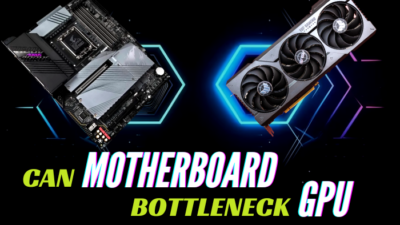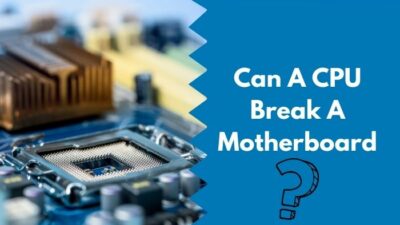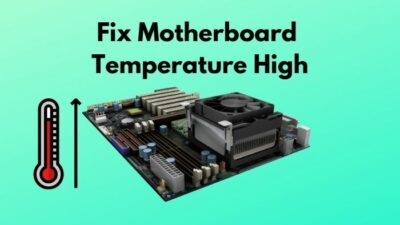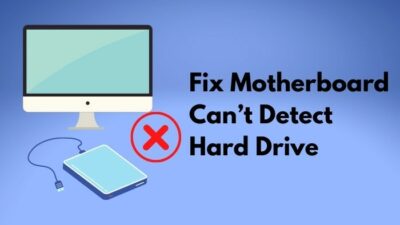A motherboard is the core component of a computer that controls all of its components.
However, the circuit can be sorted if electricity generates an excess of voltage streaming and causes an excessive current flow in a motherboard’s IC.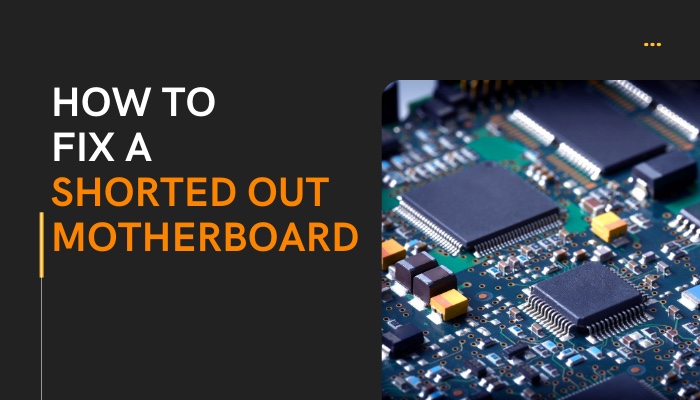
So, in this article, I will show you how to repair a shorted-out motherboard and why this problem occurred.
Let’s get started.
How to Fix a Shorted Out Motherboard
To repair a shorted motherboard, the user can reset the RAM module, then unplug the motherboard from the power supply, replace any damaged motherboard components, and carefully clean the dust between the ICs on the motherboard.
Before you repair the motherboard, you should check it for short circuits since you must apply a fix for your motherboard based on the short circuit type. There are various methods for determining a motherboard short circuit. Simply follow the steps outlined below.
Here are the steps to verify a motherboard short circuit:
- Turn on your PC and look for a green light on the motherboard.
Note: When the green light does not flash after turning on the computer, there is a problem with the motherboard.
- Install only RAM and CPU on the motherboard and turn on your PC.
Note: If the motherboard does not power up with RAM and CPU, there is most likely a problem. The motherboard can not boot up without RAM and also without a CPU.
- Remove the CMOS battery from your motherboard and turn on your computer.
Note: In case your motherboard boots without the CMOS battery, it is in good functioning order. When your computer does not boot up, this indicates an issue with your motherboard.
If your motherboard does not switch on after going through the preceding steps, it may have a short circuit and must be repaired.
The repair process is basic and straightforward. Simply follow the methods outlined below.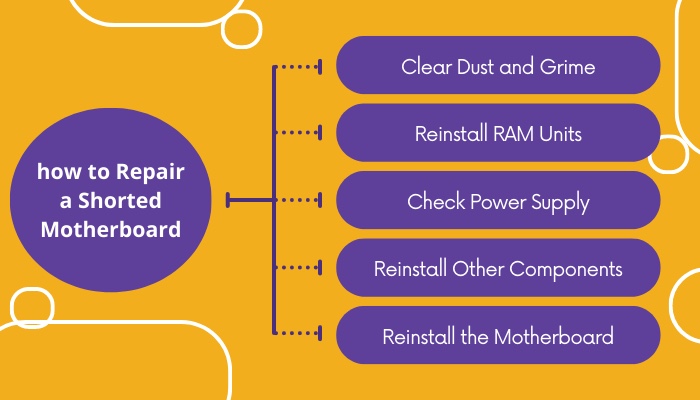
Here’s how to repair a shorted motherboard:
1. Clear Dust and Grime
Debris or dust can occasionally come in direct contact with the motherboard’s circuitry, resulting in a contract between the transistors. When two transistors are connected, the loop of electrons traveling through them is closed. Because of this, a motherboard can be shorted out.
So, cleaning away the dust and grime on the motherboard might thus remove the connection between the transistors and resolve the short circuit problem of your motherboard.
Here are some ways to remove dirt and dust:
- Remove dust from the motherboard with a blower or brush.
- Wipe the open region of the motherboard with a piece of cloth to remove dust and oily substances.
- Wipe the plastic portion of the motherboard gently with rubbing alcohol.
After cleaning, reconnect your motherboard and see whether it boots up. If your motherboard does not boot, proceed to the following method.
2. Reinstall RAM Units
Sometimes RAM slots are filled with oily material, which allows electricity to travel between the negative and positive poles of the RAM IC. because the link causes the motherboard to be short.
If the RAM is not correctly seated in the RAM socket, the motherboard may also short circuit. The short circuit problem can be fixed by correctly installing the RAM and removing the grease buildup from the RAM socket.
The following are the proper ways to reinstall RAM units:
- Using an eraser, wipe the RAM stick pins and the DIMM slots.
- Install the RAM securely into the motherboard RAM socket.
Note: If you have additional RAM chips connected, try using just one and changing the socket if the issue continues. Ensure the stick is securely inserted by applying steady pressure.
Follow our guide on how to connect extra Fans to Motherboard.
3. Check Power Supply
Before blaming your motherboard for a short circuit, ensure your power supply is operational. Turn on the power supply without any connected components. If it turns on, it signifies the power supply is working correctly and your motherboard is short-circuiting.
A loose PSU connection might potentially cause a short circuit in the motherboard. As a result, properly reconnecting all power supply connections can resolve the short circuit issue.
The power supply can check as follows:
- Disconnect all cables from all components.
- Unplug all the wires from the power supply.
Note: You must do this if you have a modular power supply.
- Reconnect all the cables and components.
- Turn on the PSU.
After reconnecting the power supply’s cables, check whether your motherboard is operational. If it’s not working, proceed to the next step.
4. Reinstall Other Components
Another cause of short circuits is inaccurate connectivity between the system and the devices. Reinstalling your video card, hard drive, and other similar components may resolve the issue.
The following sections explain how to replace other components:
- Remove each component from its slot.
- Using an air blower, remove all dust from the parts.
- Reinstall all the parts carefully.
After reinstalling all the components, restart your computer and check to see if your motherboard is still operational. If that doesn’t work, try the following method.
5. Reinstall the Motherboard
The motherboard may have ceased functioning because of an incorrect connection with the mobo plate on the casing. This problem can also cause a motherboard to short-circuit. So reinstalling the motherboard into the case can resolve the short circuit problem.
The following are the steps for reinstalling the motherboard:
- Unplug all the power connections.
- Unscrew the screw from the motherboard carefully.
- Clean the motherboard with a brush, a cloth, and rubbing alcohol.
- Reinsert the motherboard into the casing.
- Connect all the power cables properly.
After connecting all the power cables, restart your computer to see if your motherboard is operational. If your motherboard is still not working, you must return it to the manufacturer’s warranty or purchase a new motherboard.
Follow our guide to fix Motherboard error 99.
What are the Common Causes of Short Out Motherboard
Loose components, excess or insufficient power, and dust-clogged components are all common faults of users that can damage a motherboard. Users who need to know how to manage the components or are unfamiliar with this hardware can make mistakes that can damage the motherboard.
The first error users made was the improper installation of components such as coolers, GPUs, and storage devices.
When components are not set correctly, internal devices’ connection is disrupted. As a result, the motherboard can become damaged and stop performing perfectly.
Another mistake users make is failing to use the recommended power supply for their computers. If your PC requires 200w of electricity and your power supply only provides 150w, it can be detrimental to the motherboard.
As a result, if components do not receive adequate power, they may suffer damage.
Furthermore, people make significant errors when they do not adequately clean their computer components. As a result, dust and filth accumulate in the parts, preventing the devices from functioning normally.
Dust also prevents heat from escaping the motherboard, raising the motherboard’s temperature. High temperatures can cause the motherboard to stop working.
Can a Short Circuited Motherboard be Fixed?
Typically, only minor motherboard defects can be repaired, and a short circuit motherboard with most of the circuitry burned out cannot be repaired. Maintenance costs are also expensive with sorted motherboards. Fixing depends on the extent of the damage to the motherboard.
However, if most ICs and capacitors are broken, replacing or repairing them will be more difficult. Also, the cost of repairing or replacing the motherboard will be higher than that of a new motherboard.
So, if repairing your motherboard is comparable to purchasing a new one, it would be better to get a new one rather than fix it.
How Do I Know If My Motherboard is Shorted Out?
Smelling smoke or observing burnt electronics are obvious signs that your motherboard is shorted out. Additionally, you can inspect the motherboard’s round capacitors, which are placed throughout and may exhibit a burnt or damaged indicator.
The capacitors control the energy that goes to specific parts of the motherboard. Any kind of power fluctuations or overheating can damage them. When a capacitor is overloaded, it burns from the inside out and has a smoky odor.
If you smell a burnt smell coming from the capacitor, it indicates the motherboard is shorted out.
You may wonder what happened to your motherboard after it was short-circuited. I’ll answer the question in the section below.
What Happens if you Short Circuit a Motherboard?
Your motherboard will emit a burning smell, and you may notice smoke coming from it when it is short-circuited. You will also see that your mother has no power, and your computer will not boot up when you turn it on.
If you are not careful enough, your other components can also get damaged because connected, sorted-out devices can get damaged. So, if you notice your motherboard has shorted out, detach all other components from it.
FAQs
What is the cost of repairing a short-circuit motherboard?
The cost of fixing your motherboard can vary based on the degree of damage. If the damage is severe, repairing the motherboard will cost more money than if the damage is minor.
What are the Symptoms of a Motherboard Short Circuit?
The most common sign of a broken motherboard is an entirely lifeless machine. If the mobo dies, fans, disks, and other devices may start up. However, when you turn on the computer, nothing occurs. There are no beeps, lighting, fans, or anything else.
How do I know if my motherboard is fried?
Inhaling, smoking, or seeing burnt electronics are clear indicators, but also look at the capacitor, which is round in shape and located throughout the motherboard.
They control the energy that goes to specific parts of the motherboard, and power fluctuations or overheating can destroy them.
Conclusion
An electrically shorted motherboard is a major inconvenience for consumers because it costs more than purchasing a new motherboard. If the damage is minor, you should be able to fix it independently.
To assist you with the repairing approach, I have shown some solutions in this post that can fix the motherboard shorted issue.
If you have any questions or feedback about this topic, feel free to leave your comment below.

